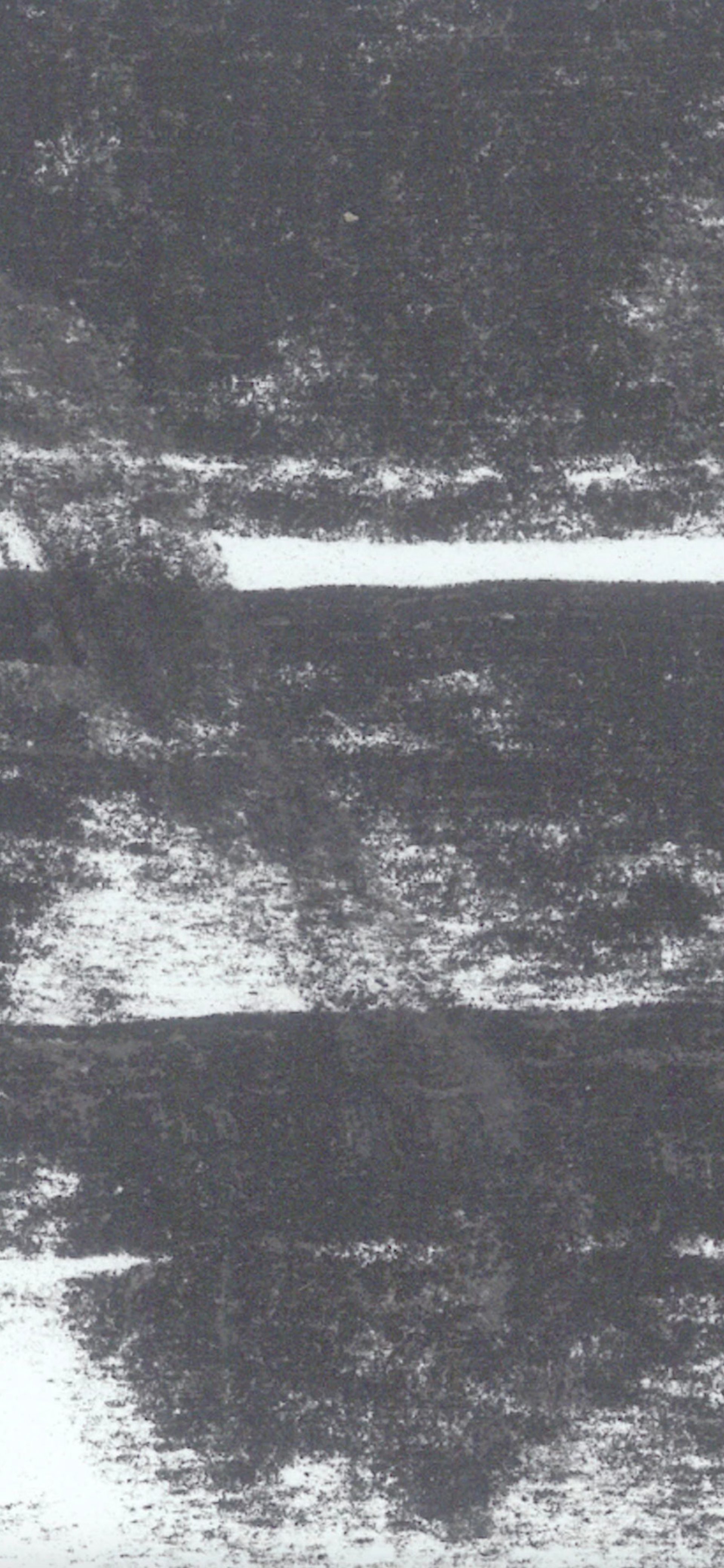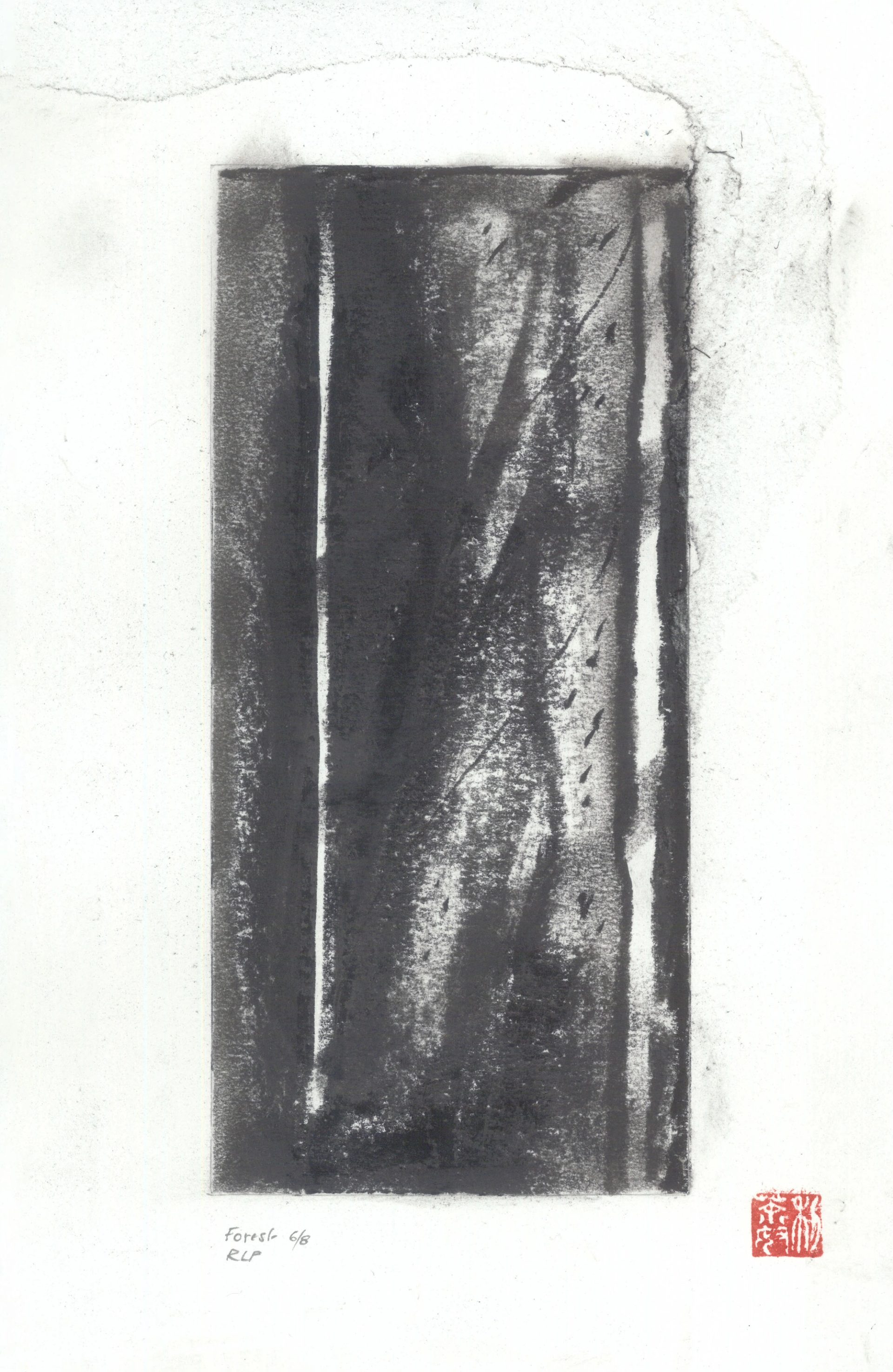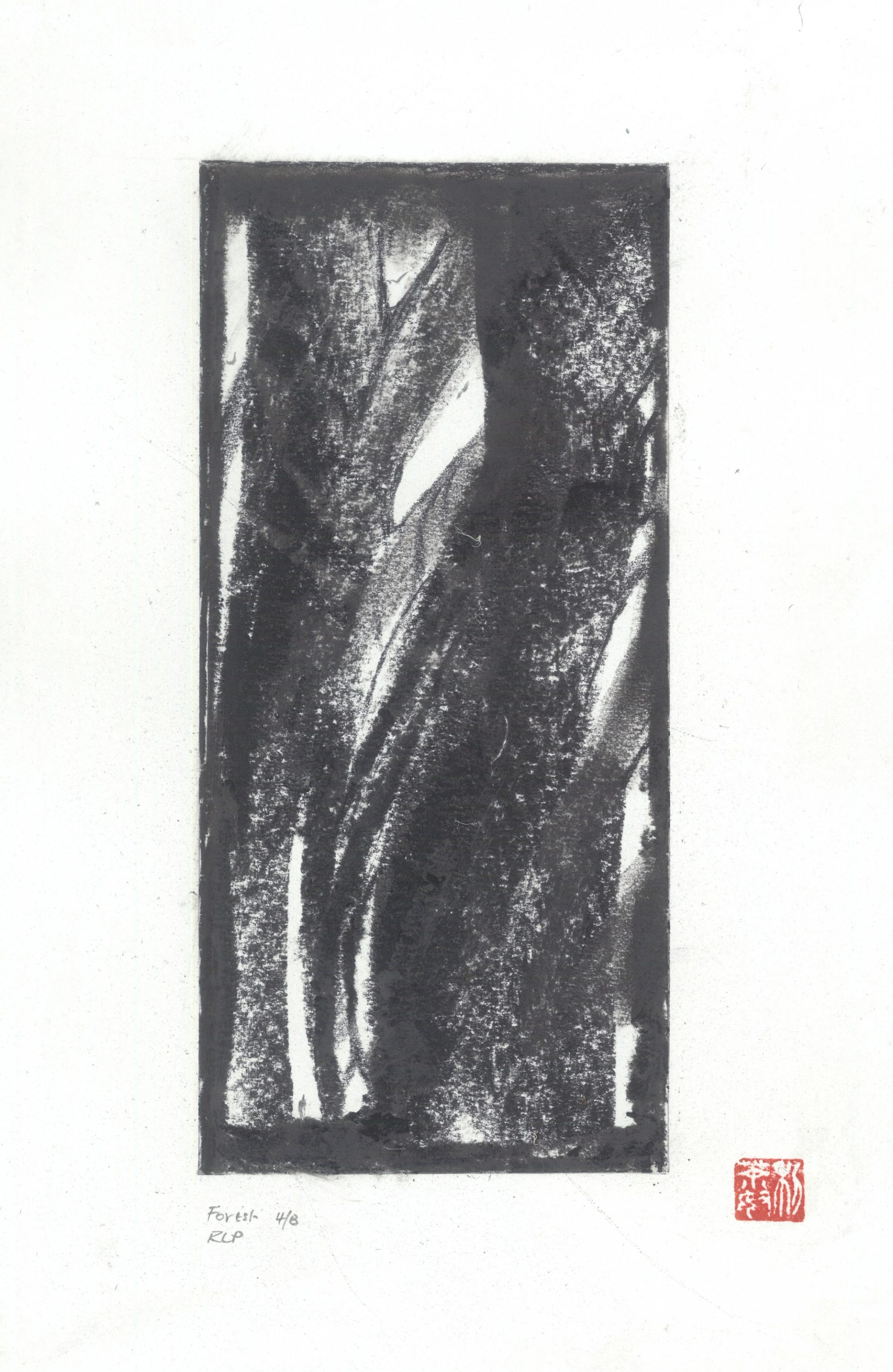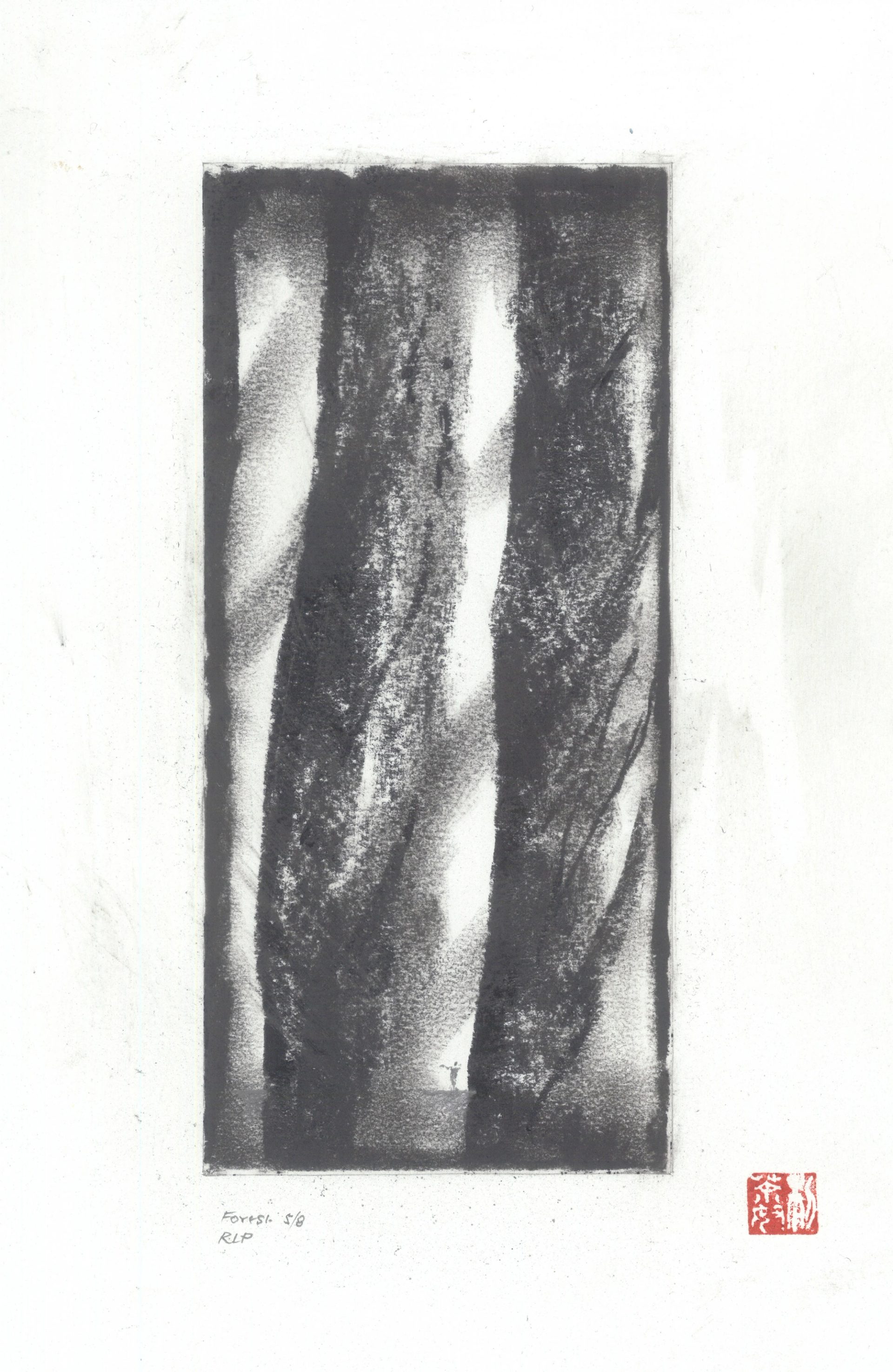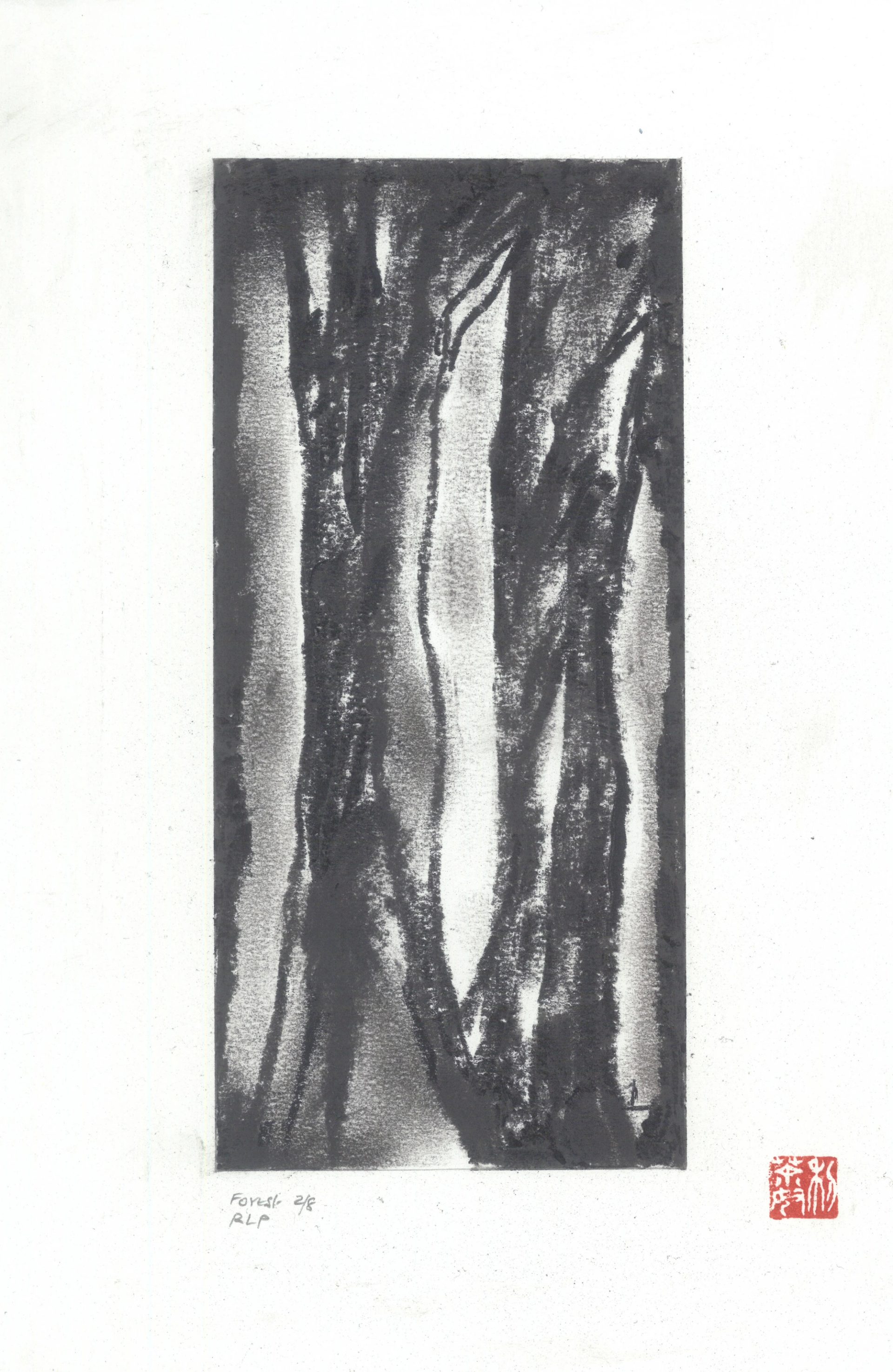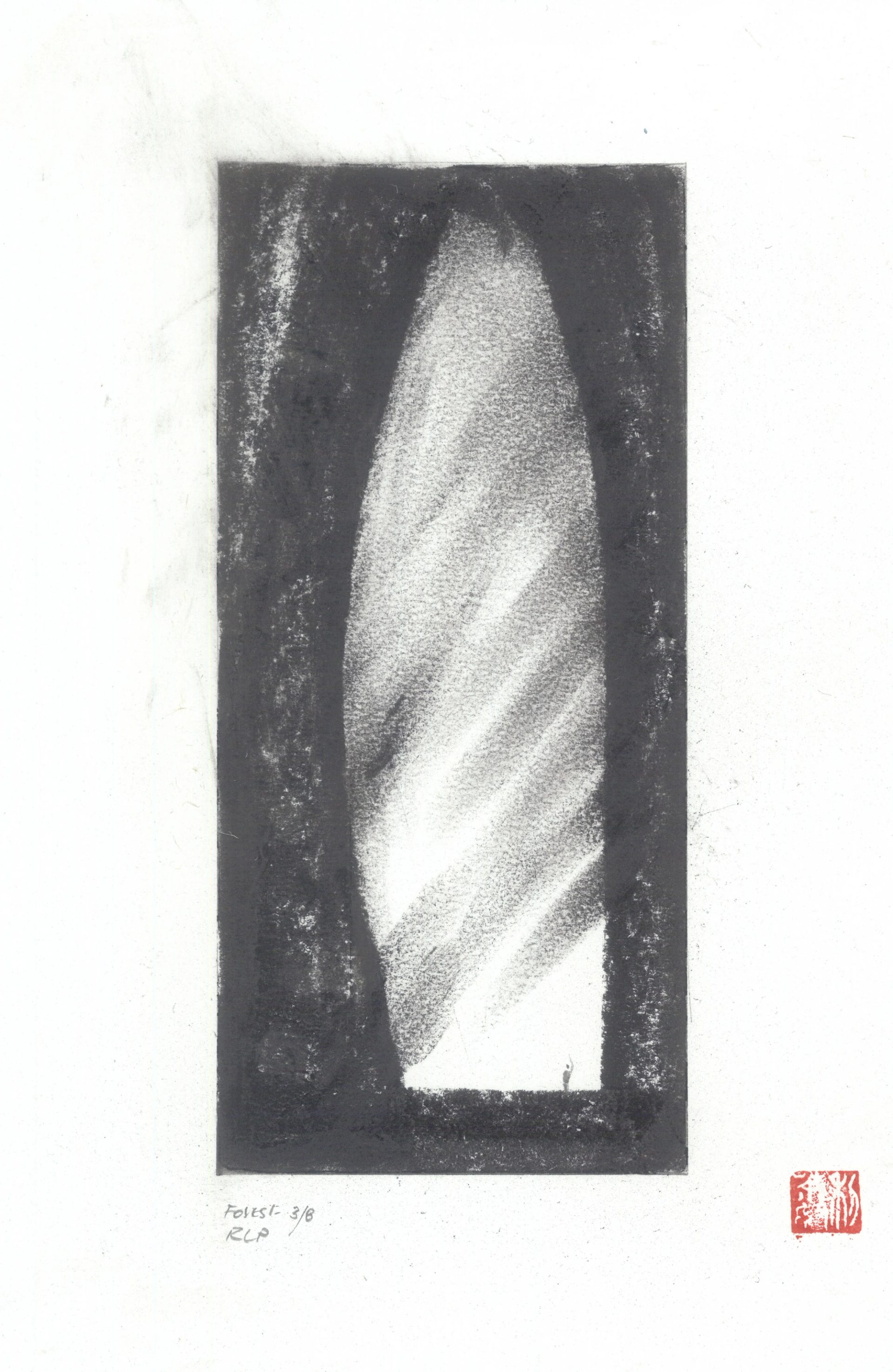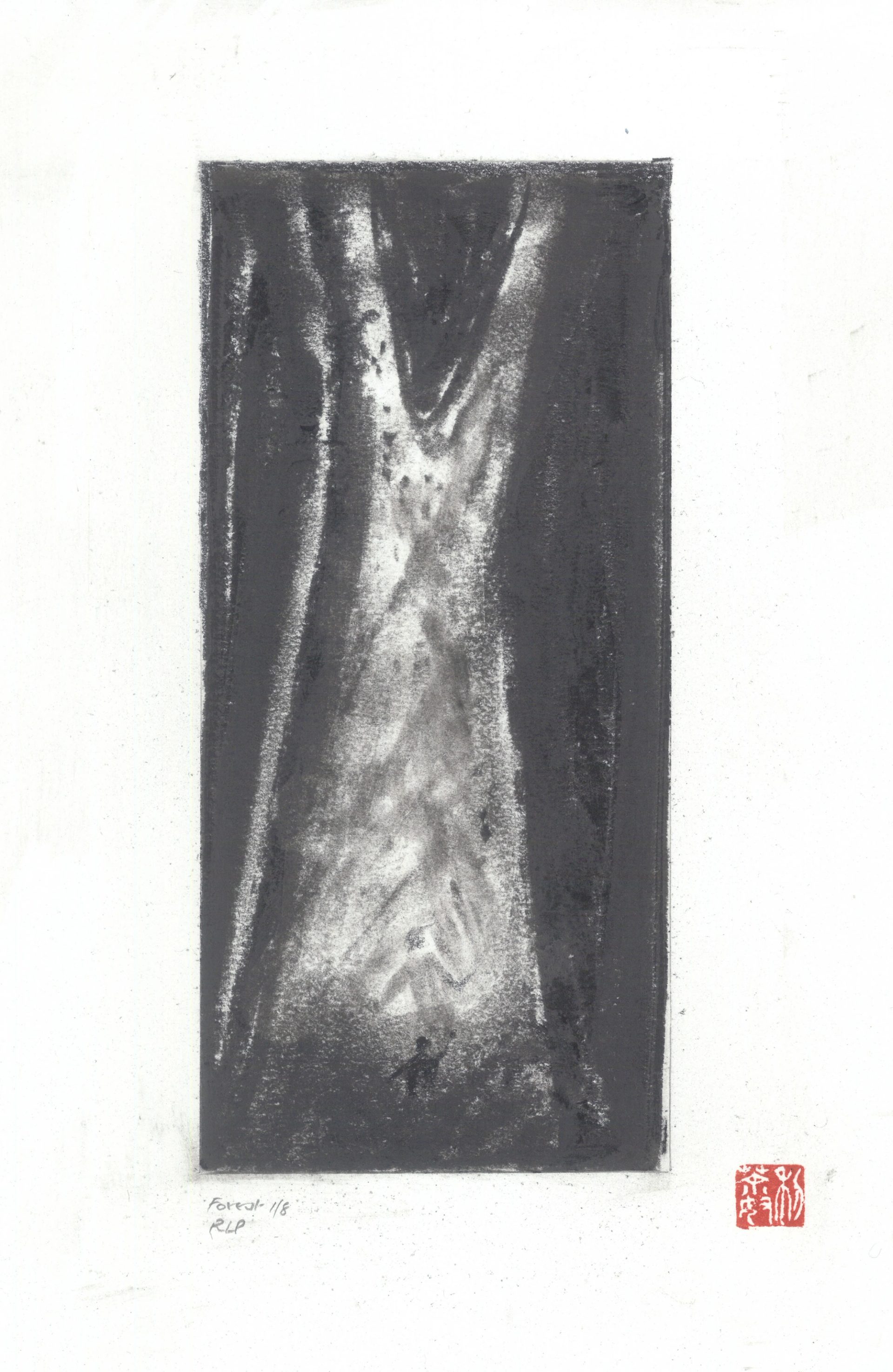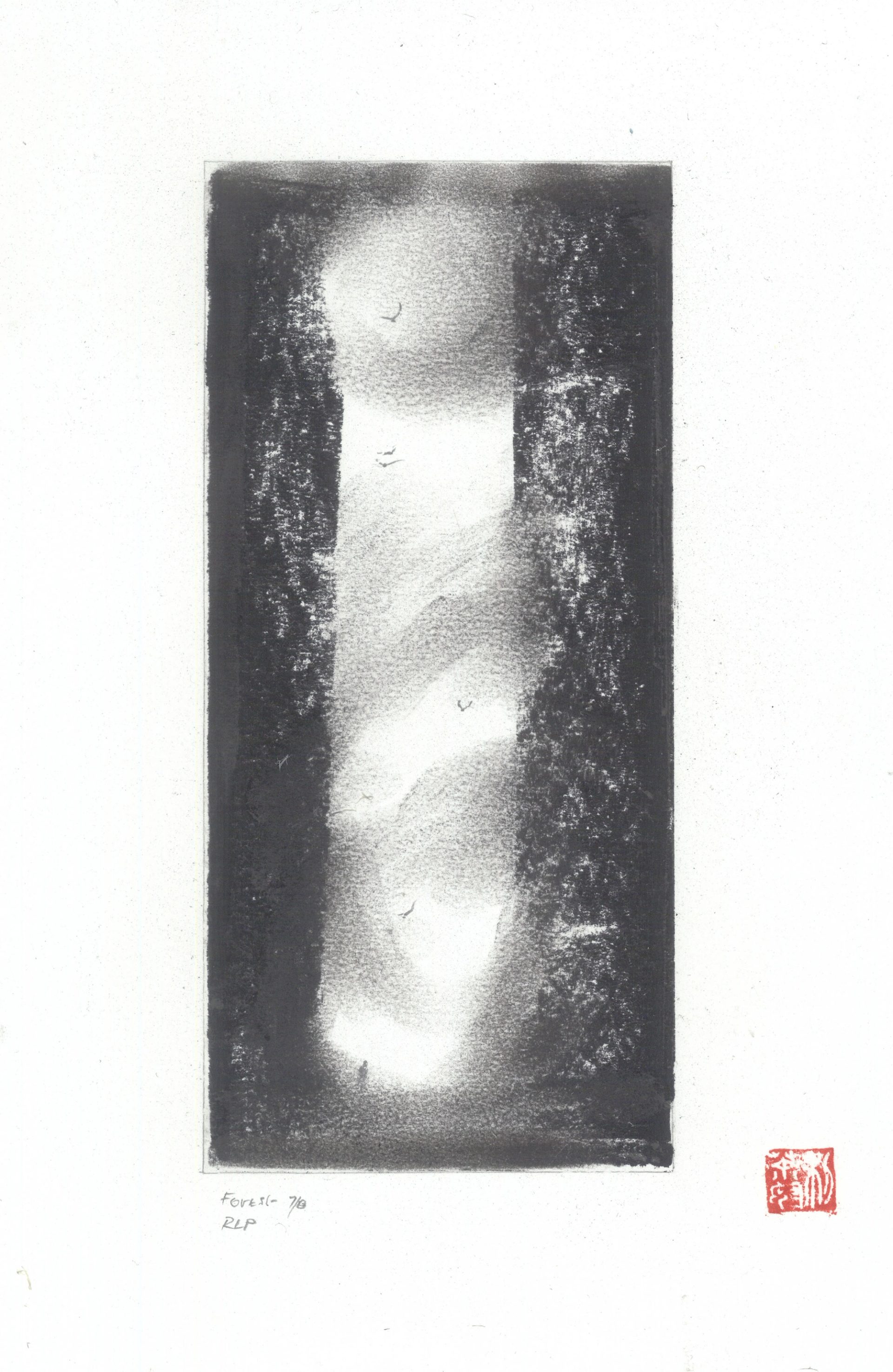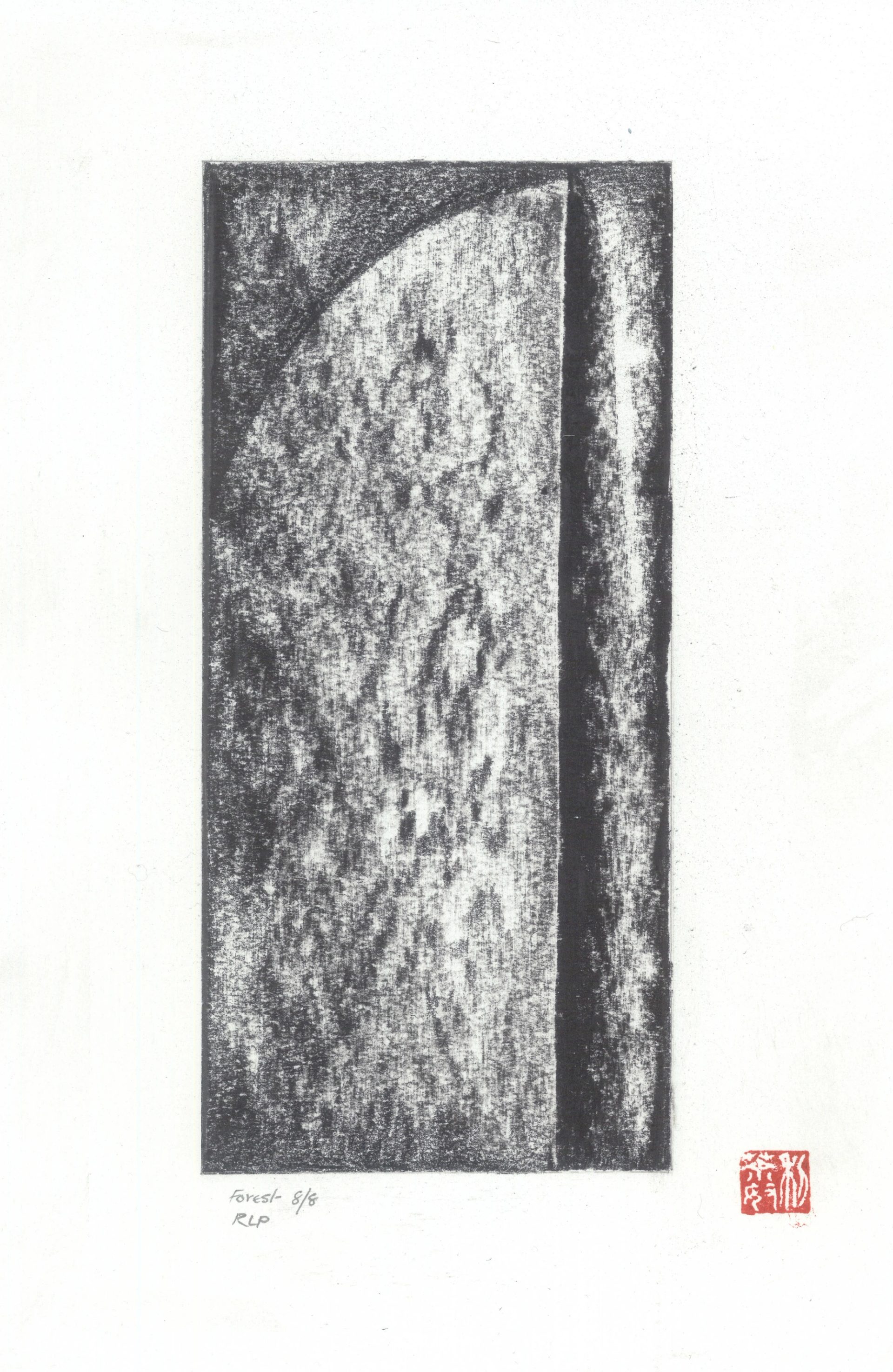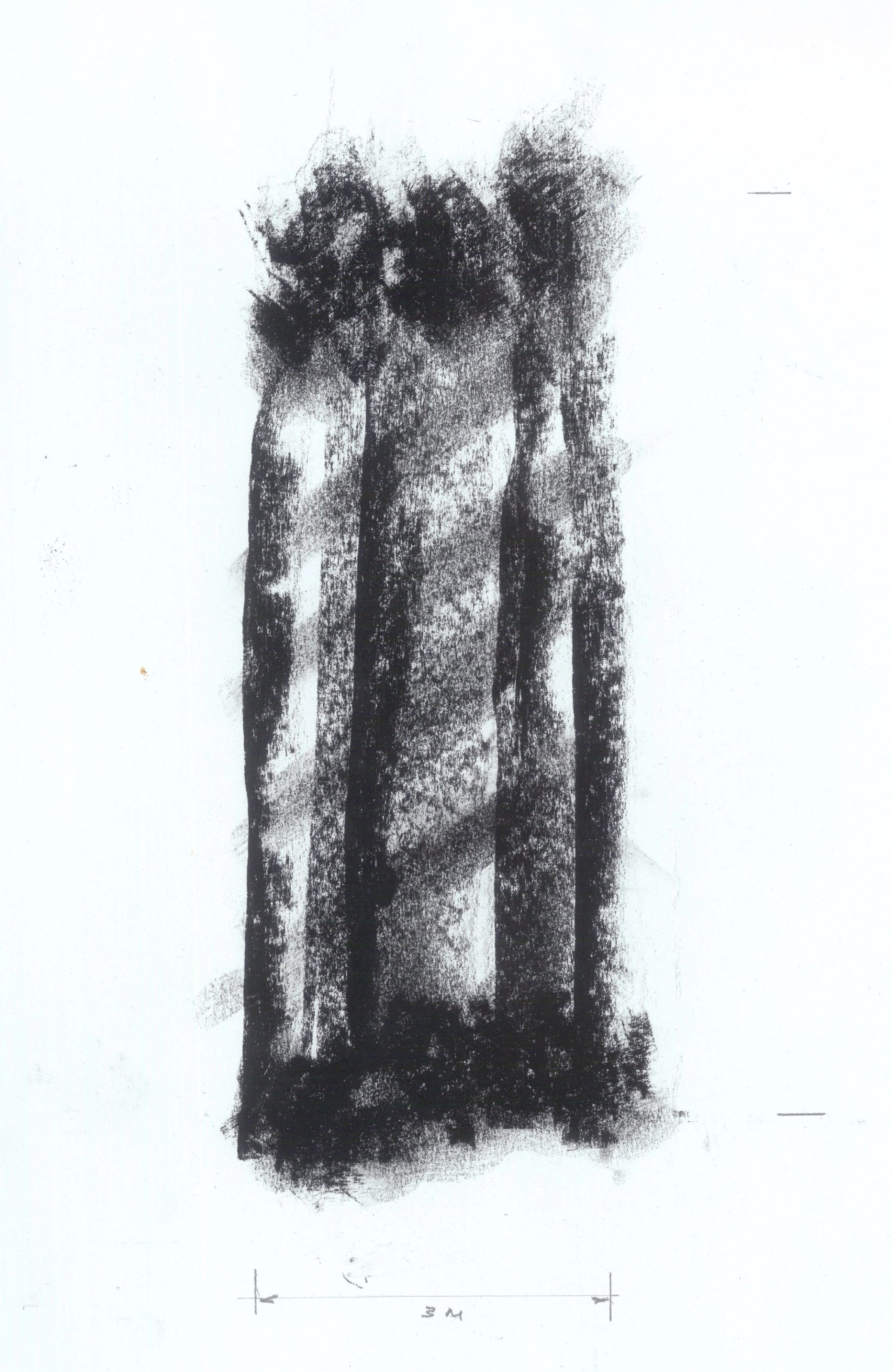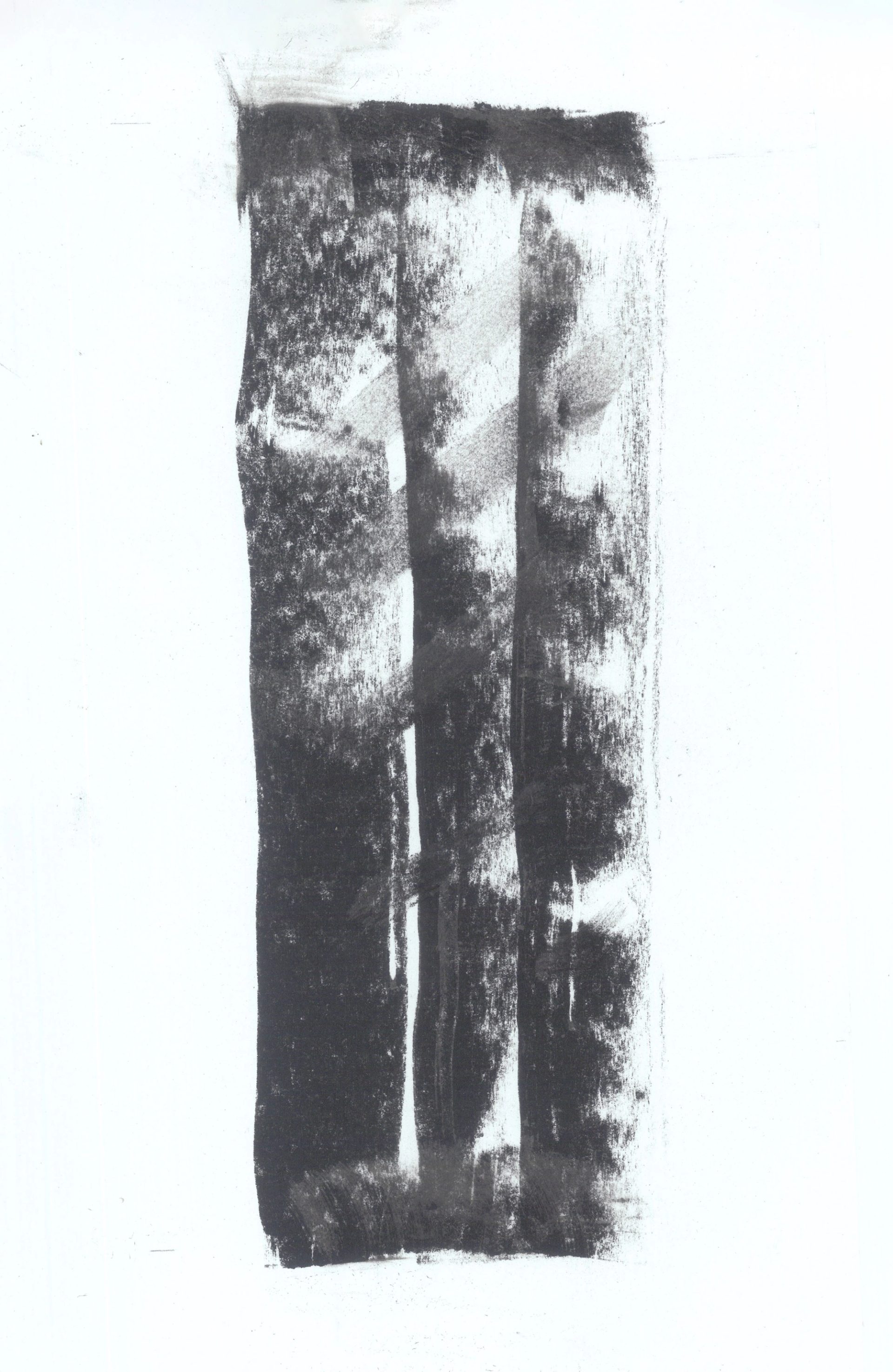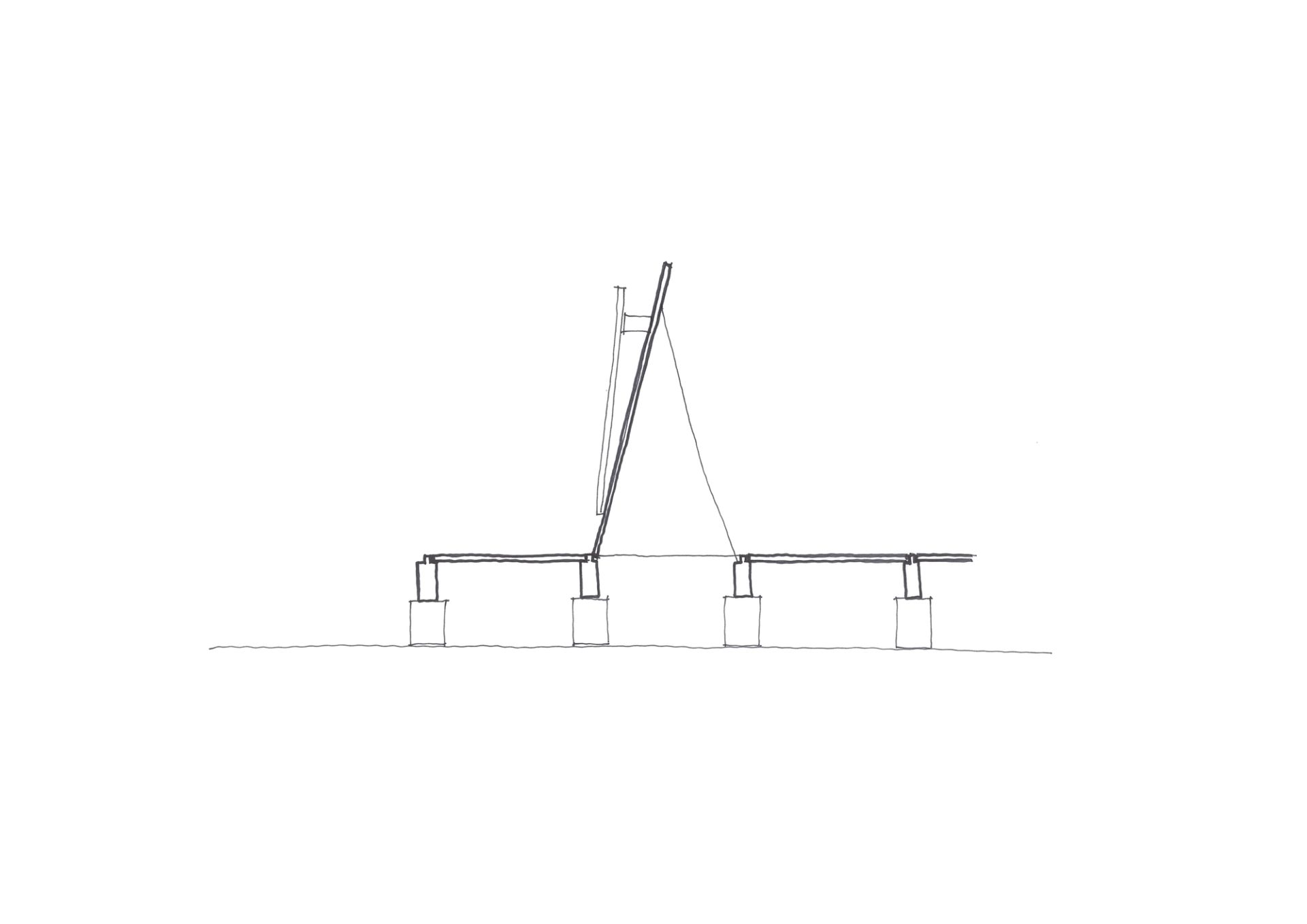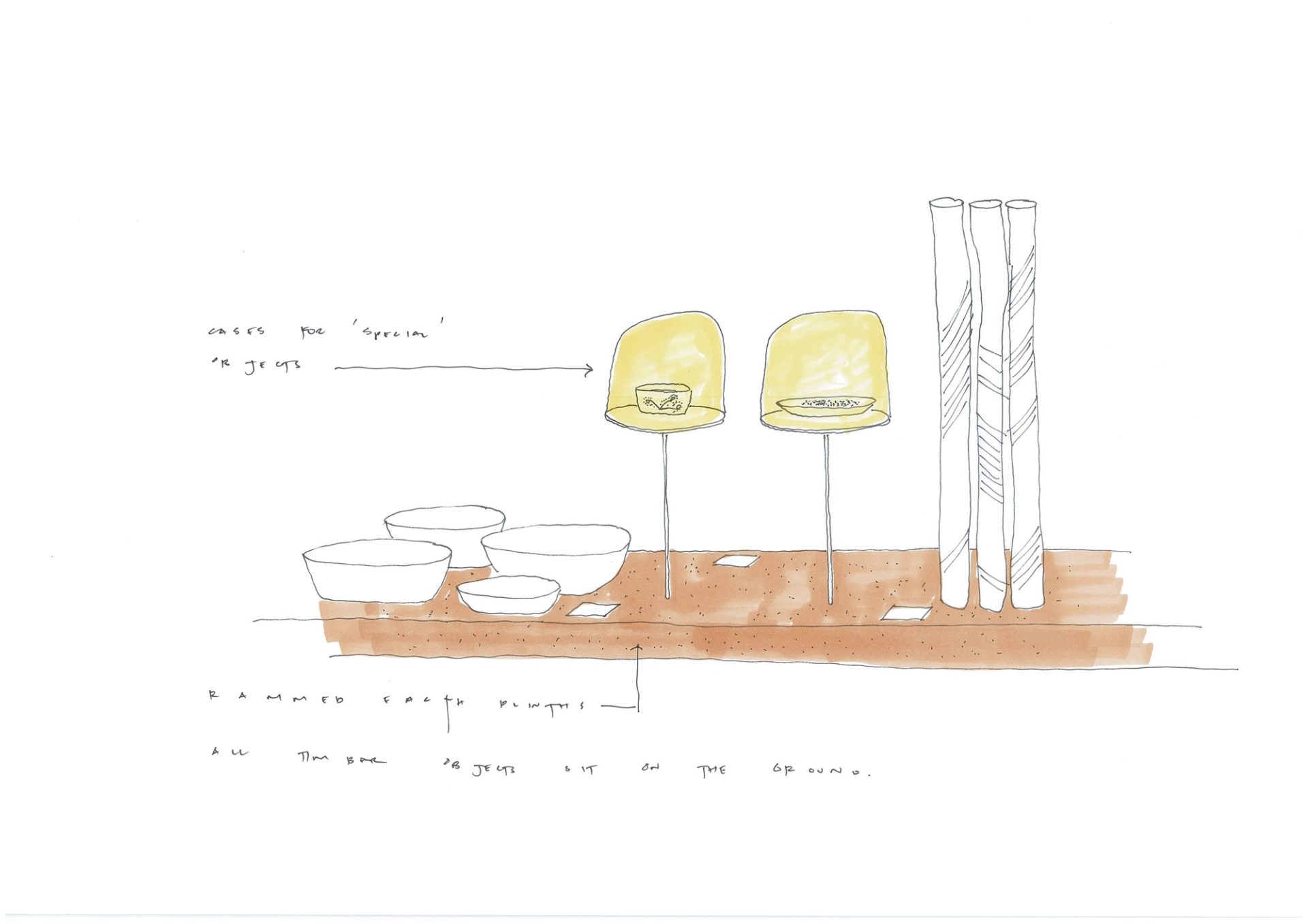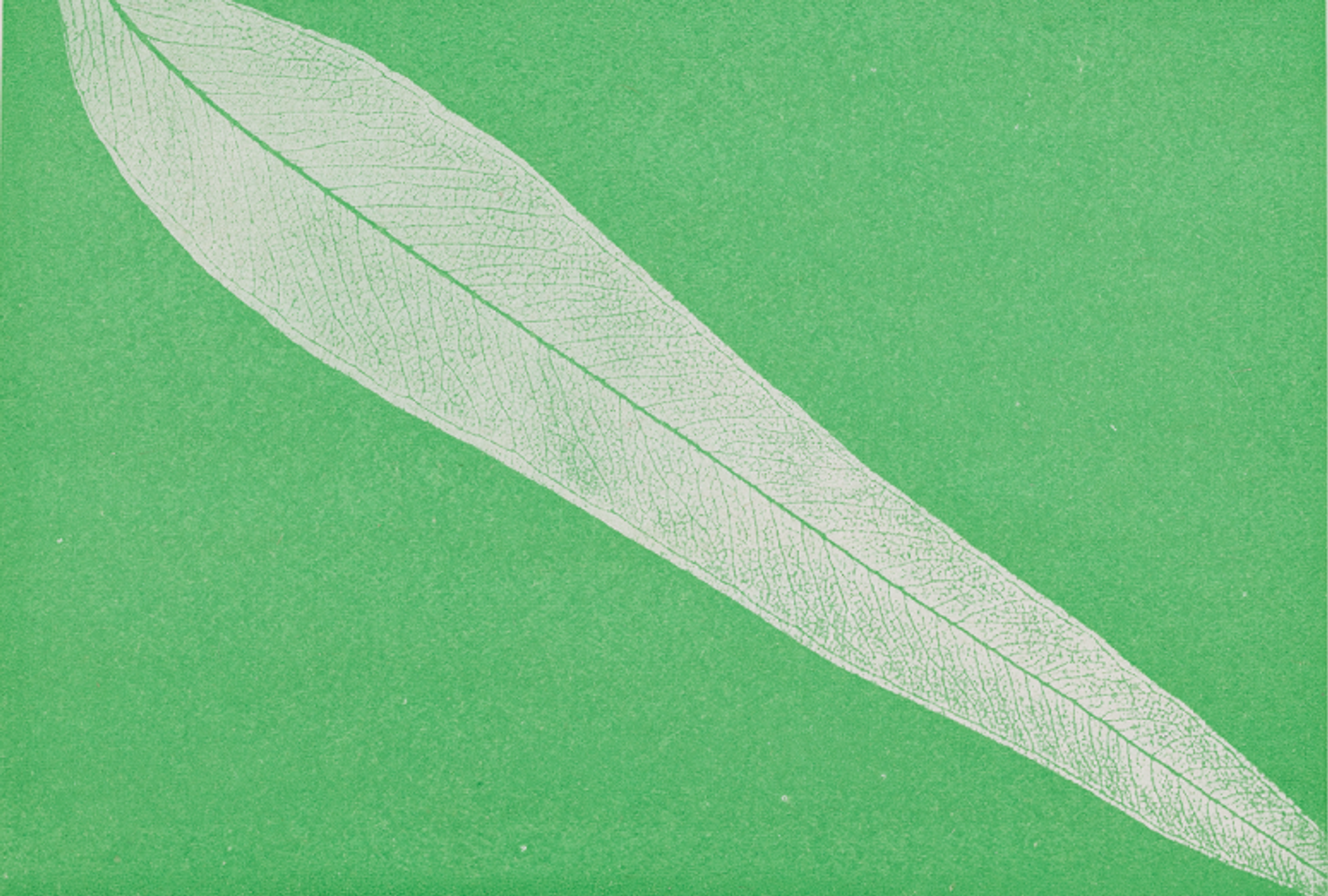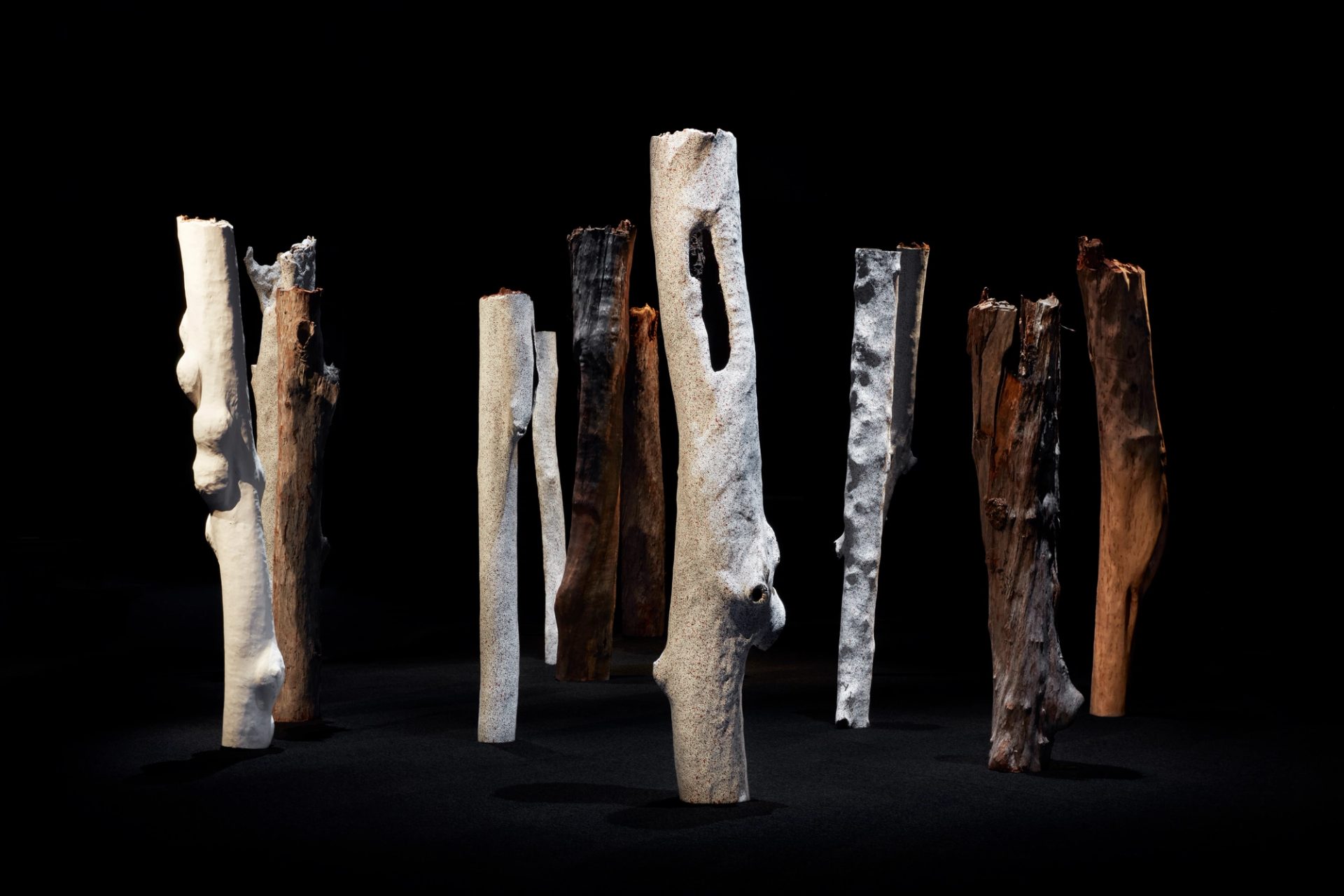The Ethos of the Forest

‘They are drawn from my mind. I walk the forest around my home all the time, but the drawings are to evoke the feeling of any eucalypt forest.’
The Eucalyptusdom exhibition design team – led by Adam Haddow and Jack Gillmer of SJB in collaboration with Richard Leplastrier AO and Vania Contreras – recently won the interior-temporary category at the World Architecture Festival 2023. In this extract from the exhibition’s companion publication Eucalyptusdom (Powerhouse Publishing, 2022) Gillmer and Leplastrier share how their collaboration began and discuss some of the principles that underpinned their approach.
Exhibition design is often thought of as scenography; a set upon which theatrics can happen. Eucalyptusdom was instead conceived of as a terrain, a landscape that the audience — no longer just a viewer — could explore.
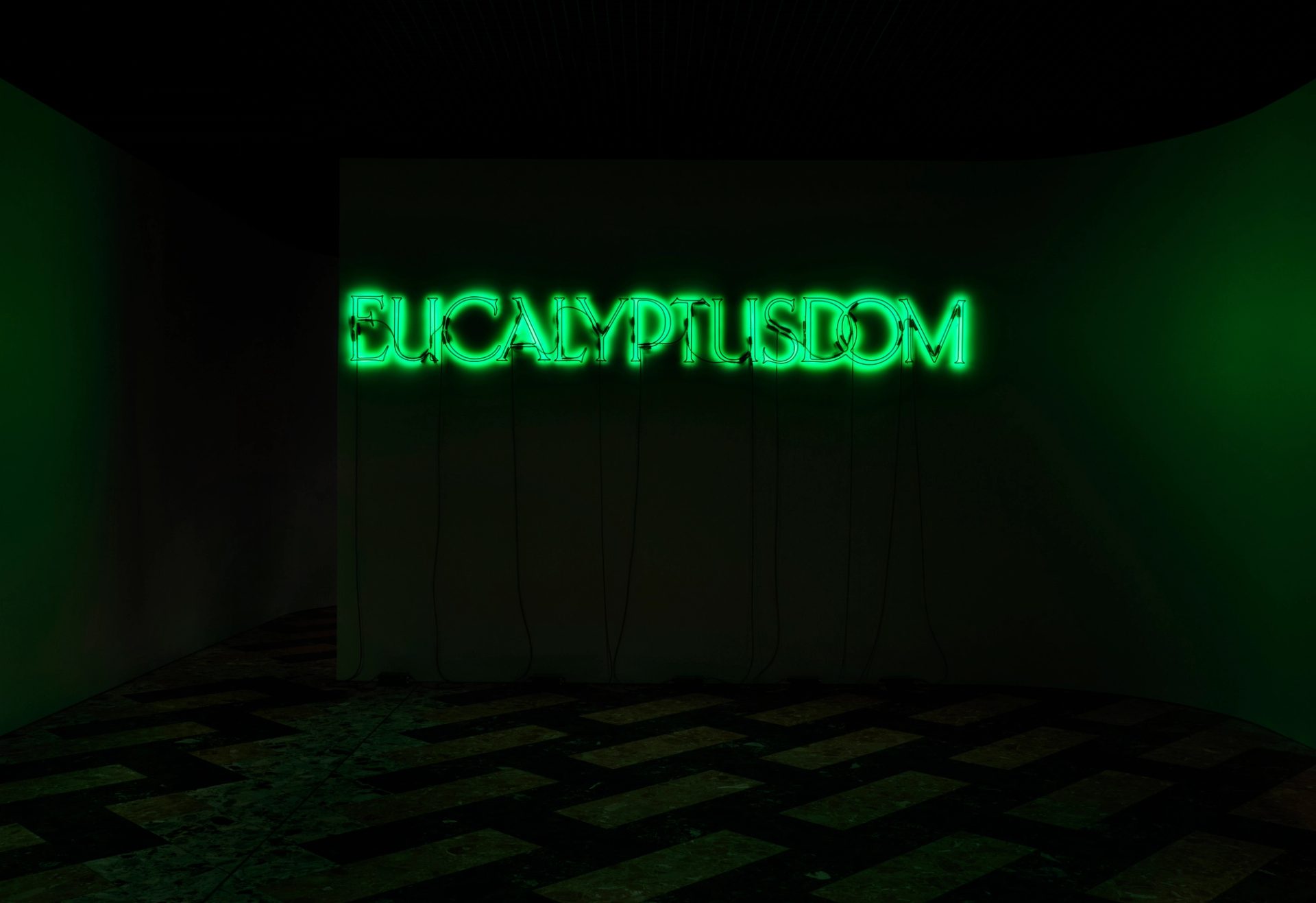
Jack Gillmer I remember when we met — I was in fourth year of my architecture degree at the University of Newcastle, where you were teaching, sharing knowledge. We were upstairs on the mezzanine, our first conversation was not about buildings, but about plants, forces of nature. Specifically, the Moreton Bay fig tree; the way it deals with the pressures of wind and tectonic shifts by developing massive buttress roots that support it. You did a beautiful sketch, which still inspires my architectural thinking.
Richard Leplastrier Ah yes, you can also always tell there’s water underground when a Moreton Bay fig has flourished. They’re like sponges. I remember that first meeting, thinking, ‘What an interesting young fella.’ You started telling me about the architectural project you were working on, how you were going to make this place where soldiers go and be dehumanised. Then you told me about your Worimi background, and I thought, ‘This bloke’s seeking something.’ And slowly, we discussed things, and you shifted your focus to probably the most important site in Newcastle: the bluff headland of King Edward Park that looks out to the south-east over the ocean. A site very important for the Worimi. And this became the departure point for your very excellent final thesis.
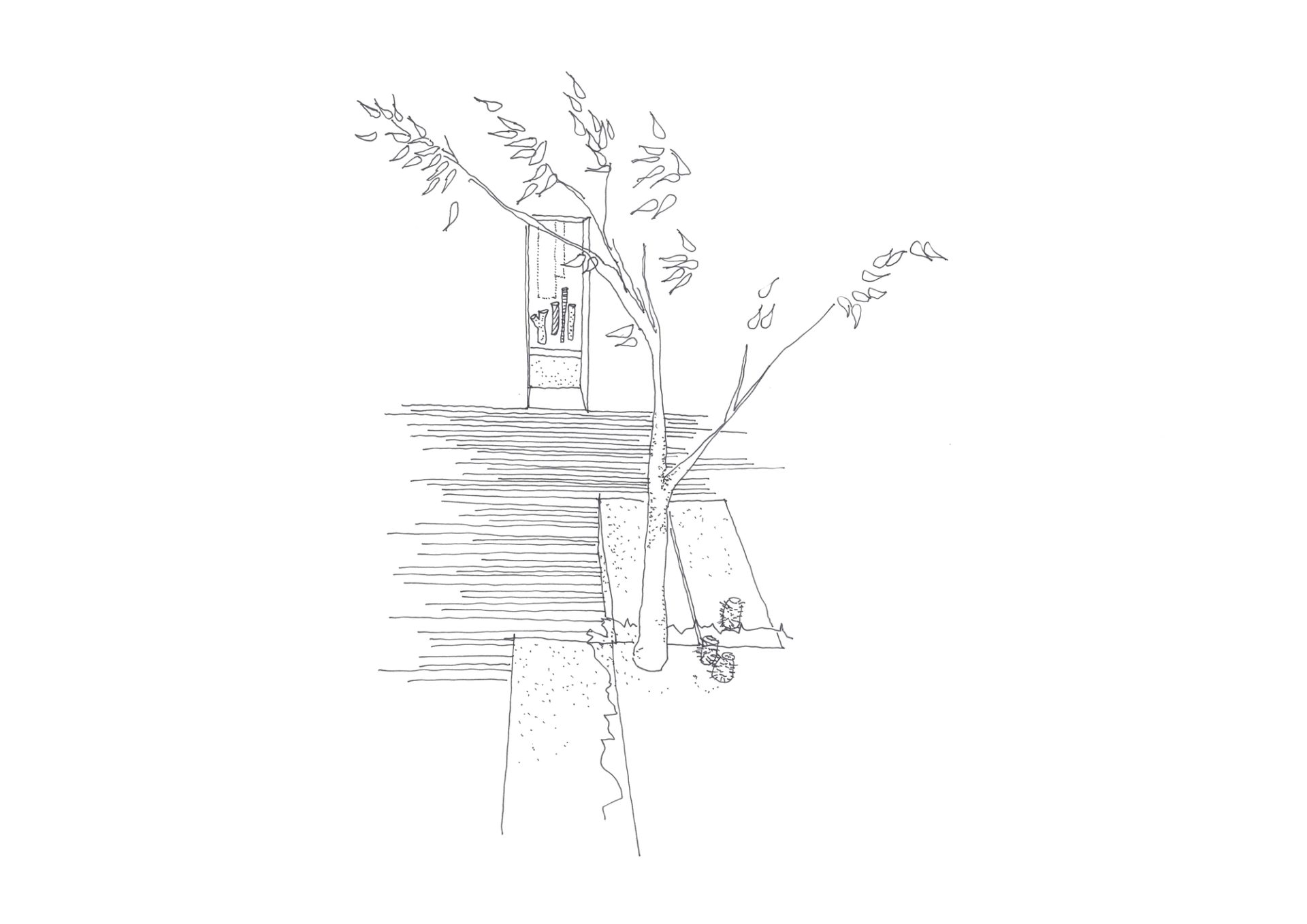
JG It was about the phenomenology of architecture and its potential to train the mind. The headland site of this project is traditionally known as Yirannali, or place of falling rocks. It’s a sacred site, the point of observation over the land and ocean. You can see the harbour and surrounding landscapes, observe the incoming seasonal fish, watch and feel the wind as it approaches, and the distant fires. It is a place of great importance. Families would take their newborn babies to the edge of the cliff and hold them up to the sky, to the ancestors, as a welcome. It was a place of great ceremonial significance, yet a lot of people don’t know about that. My project was a sculptural element, rather than a habitable building, designed to frame views and enable visitors to experience and more importantly interpret the surrounding landscape, to potentially reveal these stories of time immemorial and latent histories. So, my thinking about the phenomenology of architecture had moved on from the mental preparation of war zones, but it was still somehow concerned with conflict and conciliation.
RL And there was no holding you back after that. It was just a sheer pleasure to talk with you about those issues. Of how important it is to have a place where you can hold your newly born child up to the cosmos and introduce them to the ancestors. And why shouldn’t we be able to do that today? It was a great time. For both of us. A teacher-student relationship should be on that level.
JG Fortunately, I’ve met incredibly inspiring figures such as yourself and Peter Stutchbury. You share a considered and sensitive approach to architecture relative to the Country and culture your projects are visiting. I’ve learnt a great deal from this. It was through you and Stutch that I gained appreciation of this knowledge about the complex intersection between architecture and Country, the lessons that are learnt from studying the landscape. Not just the tangible surroundings, but things you can’t necessarily see, like the wind and the rain, embedded stories, things that Aboriginal people use to determine places that they would inhabit. They would live from a cave overhang that faces north, for instance, which is something that we have to address in contemporary architecture.
RL Much of my knowledge of the land came from Uncle Max Dulumunmun, who died in December 2021. He taught Stutchy and me that there’s an underlying force in the land, a real power in how it works and how it effects (as against affects) culture. How it levers culture. So, nature comes first and culture follows. And the whole issue of that equation between nature and culture is what’s facing us as colonisers. Uncle Max made us realise that we are on the oldest cultured Country on Earth, and that culture is our true foundation and footing.
JG The eucalypt is part of that, although to be honest it wasn’t until I worked on Eucalyptusdom that I began to reflect on and investigate my relationship with the eucalypts. I didn’t know the histories of it that you shared with me through the design process. So, it was a big learning environment for me, reflecting the power of the trees. Having lived in Sydney for the last six years or so, every time I go home to Newcastle, there’s a moment crossing the Hawkesbury River at which I always wind the window down. I never knew why I did this until the exhibition. I wind the window down because of the different smell in the air from the oils that come off the eucs across the Hawkesbury, it means home to me, that intangible sense of home.
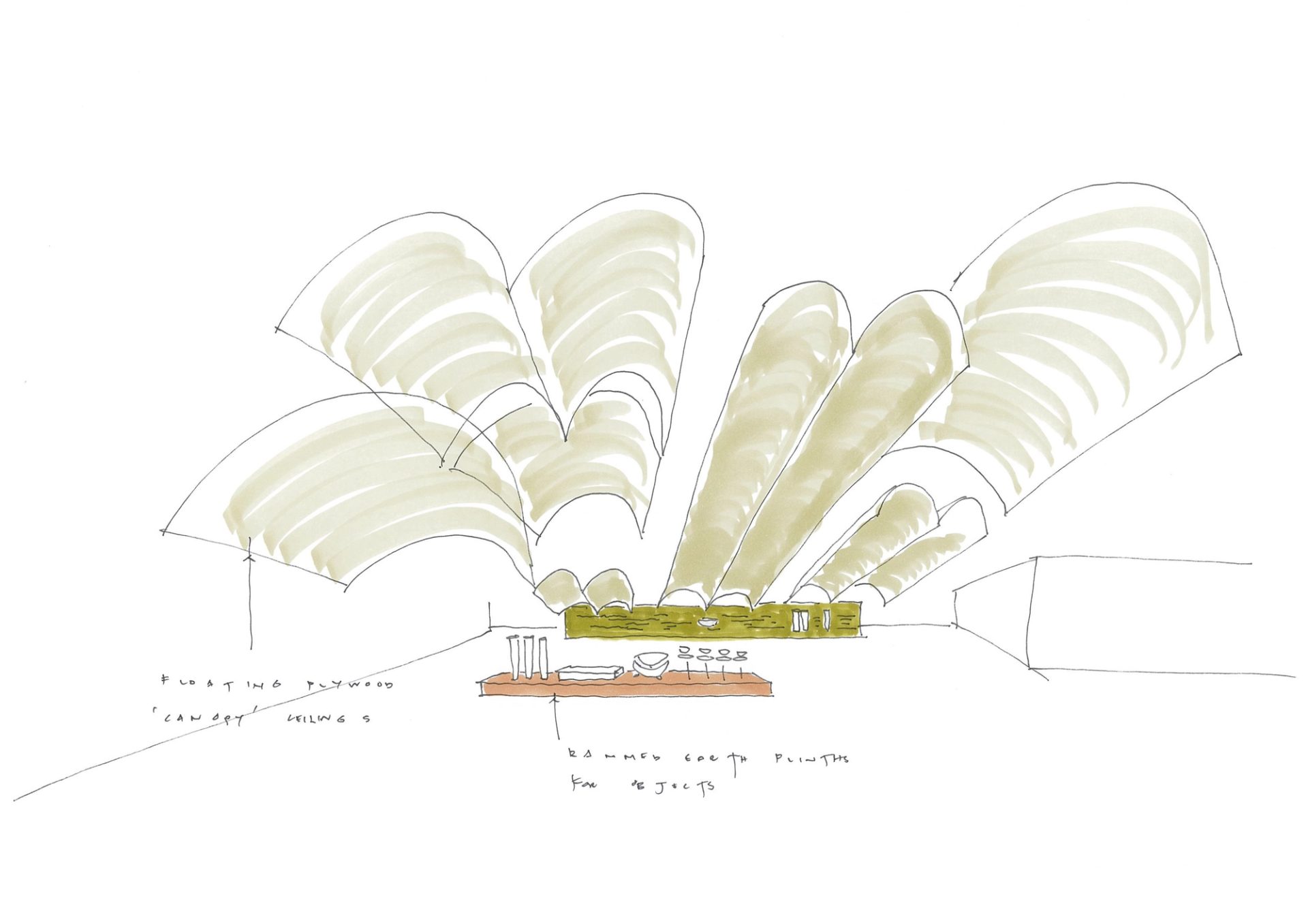
RL I am fortunate enough to live alongside a eucalypt forest on an isolated site north of Sydney and it has a very special ethos about it. The sound of the birds, the way the light cuts through early in the mornings and in the evenings, the smell of it, the sheer scale of it. These trees have seen and withstood so much history and stood for so much longer than the colonised history of Australia. The emotion they give rise to, the grandeur of the forest, the nobility of the lone tree, the richness of their history and the complexity of their systems: these are the feelings I hope we managed to convey in the imagined terrain of the exhibition. It’s about the ethos of the forest.
JG Exactly. That’s why we saw the exhibition architecture as having no direct pathway – the concept that you can get lost in the exploration of the exhibits. Even if you follow the same tracks again and again, you’re always finding something new, identifying aspects of the forest that you’d not noticed before. In the same way, every time you come back to the exhibition you might discover it over again.
RL It’s not always about what you can see, but what you can sense.
JG Jane Sheldon’s sound installation combined with noises and scents from the artworks all add to the sensory experience. In fact, it’s almost completely dark in the immense exhibition hall since all the windows are obscured.

RL Every now and then a shaft of light pierces the darkness, energising it. That was mainly the influence of lighting designer Nick Schlieper, who does wonderful work with dance and theatre. It was Nick who encouraged us to not let daylight leak in, but to direct it purposefully within the space. His sensibility is acute; he really understands space and light brilliantly. I remember when we were installing the digitally-printed banners of my charcoal drawings of the eucalypts from ceilings and Nick said, ‘Why don’t we reverse them, like negative and positive so the visitor experiences them differently from either side?’ And then we discussed the whole issue of whether they should be weighted down or not. And we decided that they shouldn’t be, that the air moving through them should be just enough to make the forest gently heave. Like in Macbeth or Kurosawa’s great film Spider Web Castle (Kumonosu-jō).
JG It was such an incredible team effort to bring this massive exhibition together. Vania Contreras, the 3D spatial designer literally brought the vision to life. Her expertise in spatial analysis, the relationship between certain elements and the different themes of the space, was invaluable. She did all the construction drawings and developed the detail of everything, quality-checked all on the architectural terrain. She considered the whole, right down to the way that artefacts were mounted.
RL And then, of course, there are all the makers, who are so much a part of the process. Matt Higginbottom from Queen & Crawford, for example, who with his workshop out at Marrickville was just brilliant. And Powerhouse is fortunate to have an amazing workshop team on site. Gavin Lewis and Penny Angrick and the team are so dedicated and talented. You can’t realise architecture without those people.
JG Especially if you’re going to design bespoke fittings, as throughout this exhibition. We started with the conviction that there should be as few elements as possible that would function in as many ways as possible to optimise potential permutations. In fact, the whole terrain is composed of just one table typology that is adapted to suit whatever display configuration is required. It can sit flat, angled, go lower or higher.
RL That’s right, we started with the idea of a low jetty leading out into and through the space from which elements could branch off. But then you took that idea further.
JG Essentially, it’s a kit of parts: the dowel rods, cogs and cams. These rudimentary elements allow the planes of timber to be tilted or turned so that the one design can evolve in 20 or so different ways according to curatorial and display requirements. That means that they can have a life beyond this immediate usage. Actually, if we look back, it was Adam [Haddow, SJB Director and core member of the Eucalyptusdom design team] who encouraged us to evolve that initial idea.
RL Adam’s great strength is his analytic skills in tandem with his aesthetic sensibilities. To be a really good architect, you need both. Especially working in group situations like this.
JG He’ll bring a crazy idea, something that’s just completely wild in order to get the team thinking. An idea that’s definitely about the project but a bit more abstract; that creates this fertile soil in which ideas can be nourished and grow.
RL He often described his role in the exhibition design as ‘facilitator’. He was the one who made the connections and brought us all together.
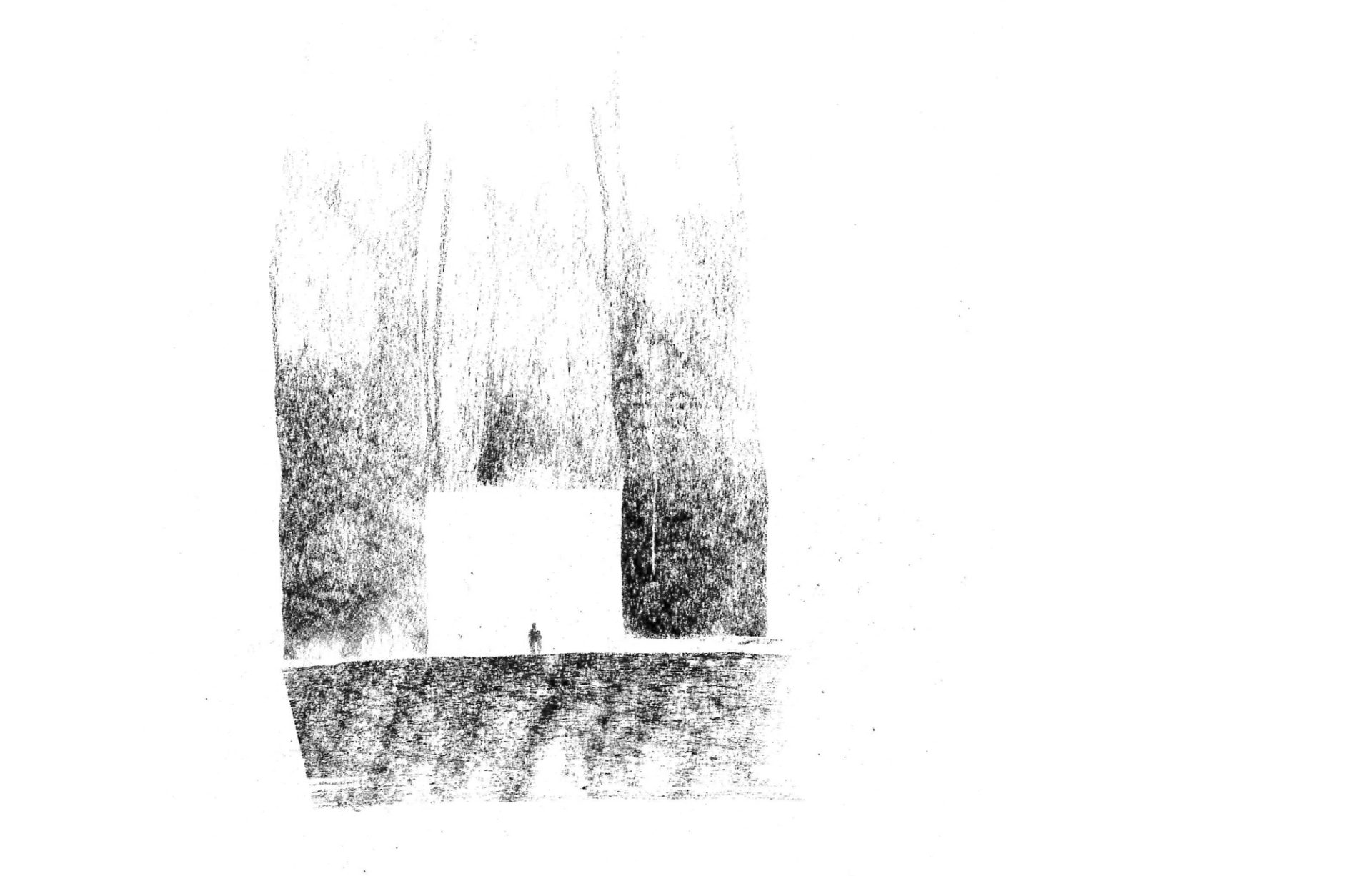
JG In concurrence with the idea of the terrain, or landscape at ground level, the question of what could happen above that, in the darkness of the high, vaulted space arose. Which led to the suspension of your evocative charcoal drawings of the eucalypts. Where did the images of these particular eucalypts come from?
RL They are drawn from my mind. I walk the forest around my home all the time, but the drawings are to evoke the feeling of any eucalypt forest. The idea was that having conceived the horizontal ground plane, to add vertical elements that rose above the exhibition to occupy, but not dominate, to help convey the power of the forest. To seed the atmosphere. It started as a simple idea in charcoal with no detail. One is less and less distracted by detail as one gets older.
Speakers
Richard Leplastrier AO is an Australian architect and educator. His career began in 1964 in the Sydney office of Jørn Utzon, assisting with documentation of the Sydney Opera House. In 1970 he established his own practice in Lovett Bay, Sydney and taught for many years as Professor of Practice in Architecture at the University of Newcastle. He was awarded the Australian Institute of Architects Gold Medal (1999), Spirit of Nature Wood Architecture Award in Finland (2004), Dreyer Foundation Prize of Honour in Denmark (2009) and received an Honorary International Fellowship of the Royal Institute of British Architects in 2015. Leplastrier was made an Officer of the Order of Australia in 2011 for distinguished service to architecture, particularly through the application of environmentally sensitive design, and as an educator and mentor.
Jack Gillmer is an architect and proud Worimi-Biripi Guri who centres his practice around Country as the driver of his architectural narrative. His work explores the tangible and intangible, negotiating multi-sensory outcomes and narratives that deliver projects of place, rejuvenating the senses and latent knowledges of Country. In his role as First Nations Lead at SJP, Jack leads and facilitates caring, designing and connecting with First Nations on projects, developing frameworks and methodologies to establish processes that are respondent to Country, and empowering First Nations community Voice, collaboration, and co-design throughout SJB’s work and beyond.
Powerhouse Publication
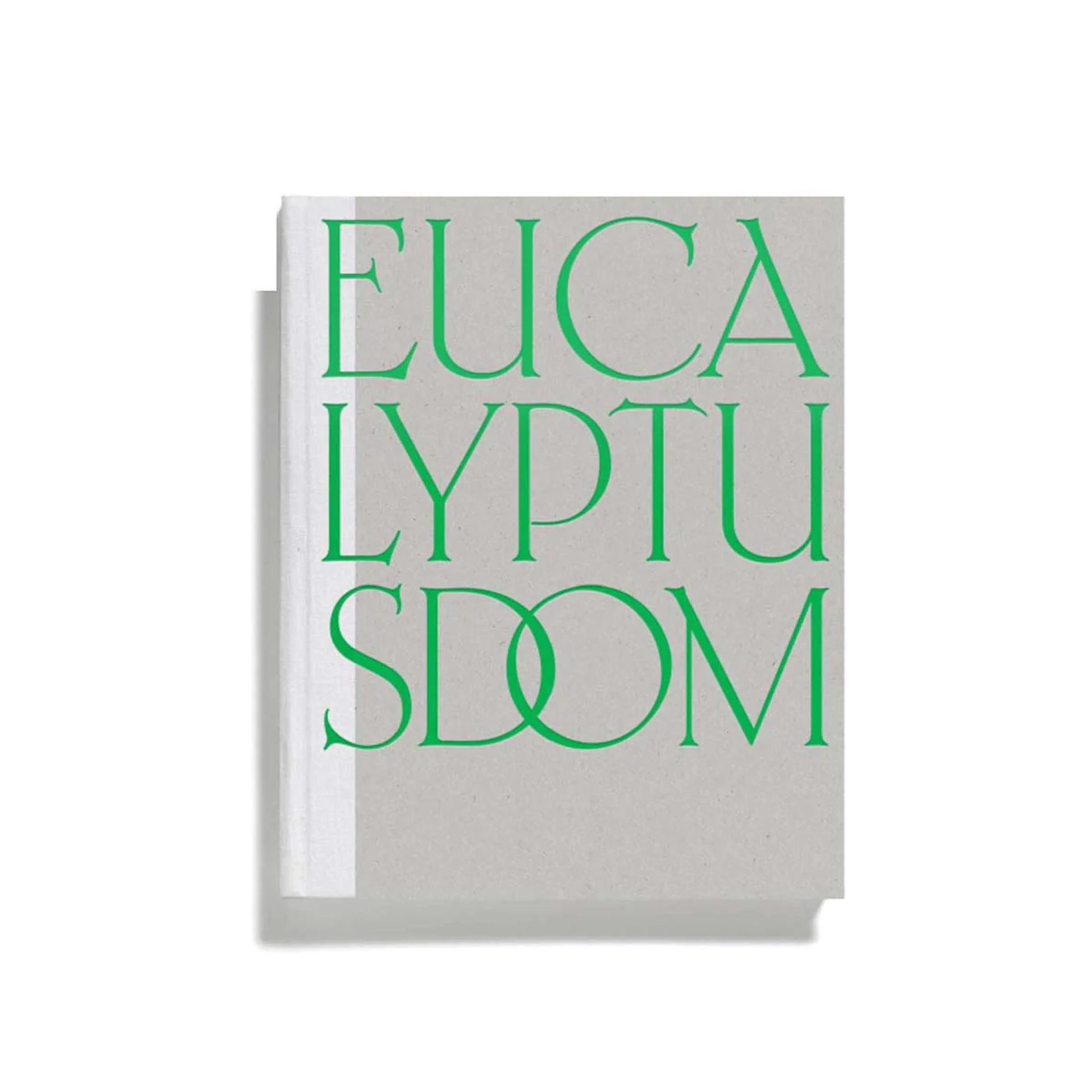
Eucalyptusdom reckons with Australia’s cultural history and ever-changing relationship with the gum tree. This publication expands upon a body of research and creative output generated via the eponymous exhibition at Powerhouse Ultimo, 11 October 2021 – 28 August 2022. It showcases the more than 20 creative practitioners commissioned to produce new works in dialogue with 500+ objects from the Powerhouse Collection. The publication also offers insights from the award-winning exhibition design team and includes a new work of literary non-fiction by acclaimed Australian author Ashley Hay, a 32-page folio of art photography by Amanda Williams, and an oral history shared by D’harawal Elder Aunty Fran Bodkin. Book Design by Studio Ongarato. Recognised with a Distinction at the 2022 Australian Graphic Design Association Awards.










